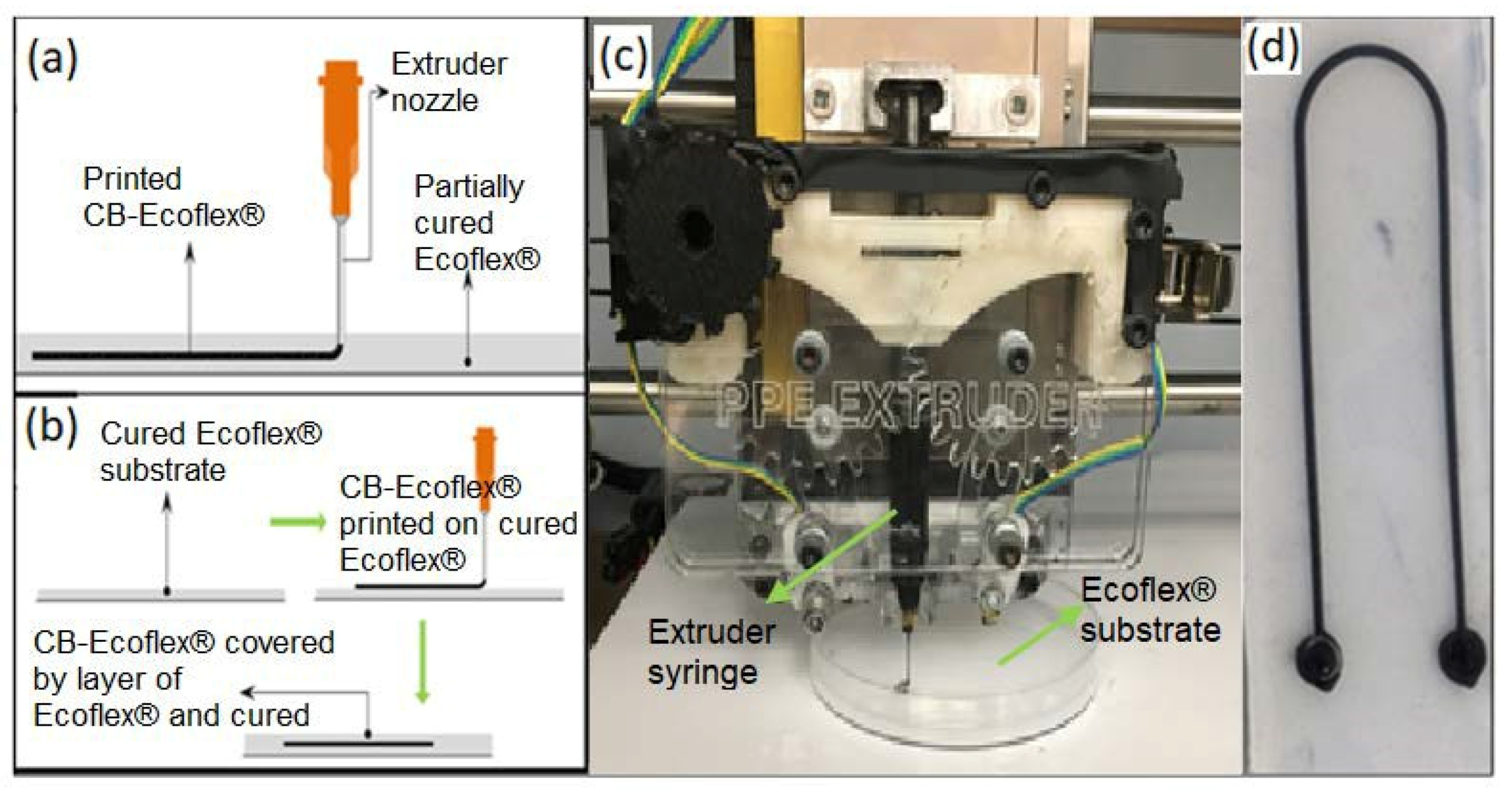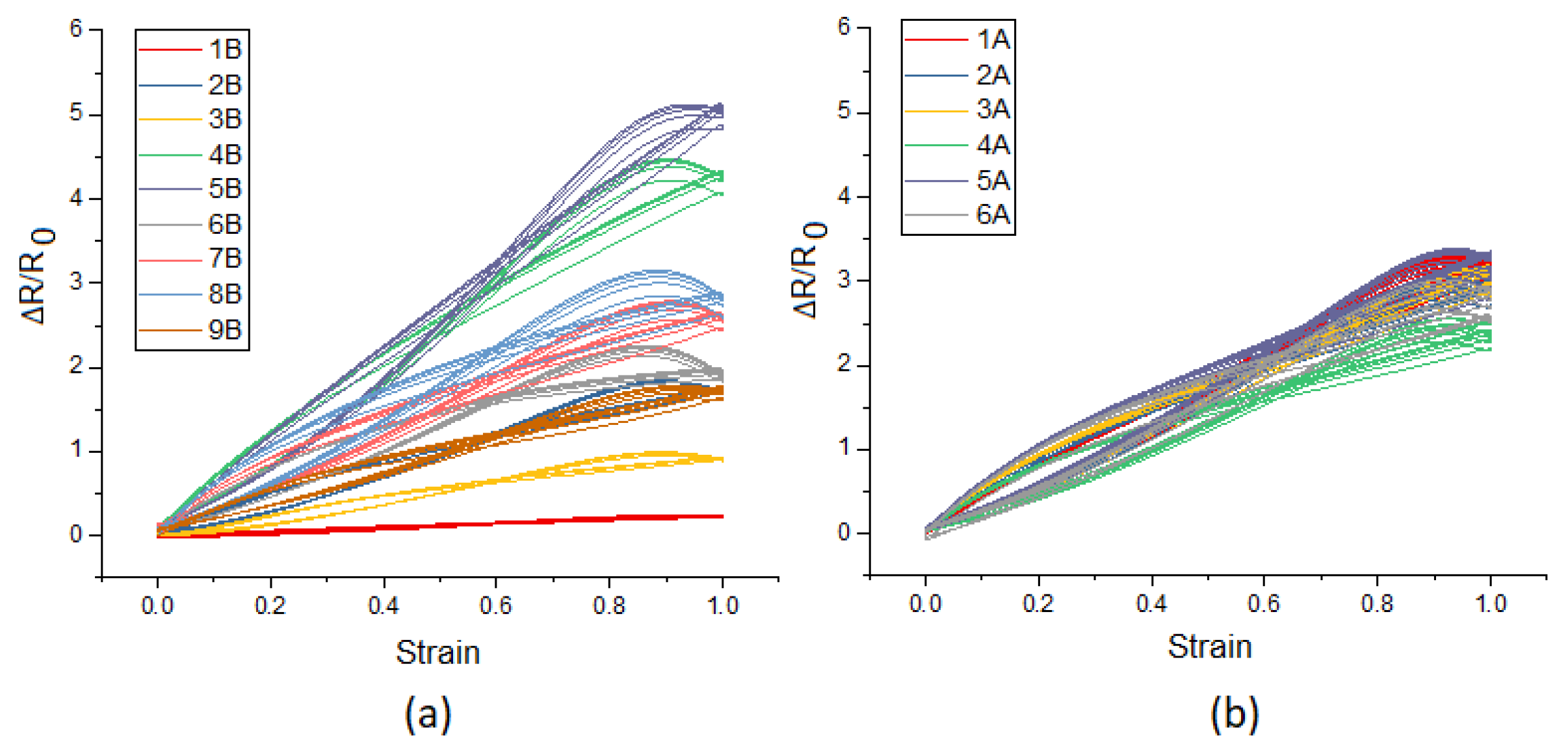Printing of Soft Stretch Sensor from Carbon Black Composites †
Abstract
:1. Introduction
2. Materials and Methods
3. Results
3.1. Strain Monitoring
3.2. SEM Micrographs
4. Discussion
References
- Jia, Y.; Do, C.D.; Zou, X.; Seshia, A.A. A hybrid vibration powered microelectromechanical strain gauge. IEEE Sens. J. 2016, 16, 235–241. [Google Scholar] [CrossRef]
- Do, C.D.; Erbes, A.; Yan, J.; Soga, K.; Seshia, A.A. Vacuum packaged low-power resonant MEMS strain sensor. J. Microelectromech. Syst. 2016, 25, 851–858. [Google Scholar] [CrossRef]
- Ma, Y.; Liu, N.; Li, L.; Hu, X.; Zou, Z.; Wang, J.; Luo, S.; Gao, Y. A highly flexible and sensitive piezoresistive sensor based on MXene with greatly changed interlayer distances. Nat. Commun. 2017, 8, 1207. [Google Scholar] [CrossRef] [PubMed]
- Kenry; Yeo, J.C.; Lim, C.T. Emerging flexible and wearable physical sensing platforms for healthcare and biomedical applications. Microsyst. Nanoeng. 2016, 2, 16043. [Google Scholar] [CrossRef] [PubMed]
- Song, Y.; Chen, H.; Su, Z.; Chen, X.; Miao, L.; Zhang, J.; Cheng, X.; Zhang, H. Highly Compressible Integrated Supercapacitor–Piezoresistance-Sensor System with CNT–PDMS Sponge for Health Monitoring. Small 2017, 13, 1702091. [Google Scholar] [CrossRef] [PubMed]
- Giffney, T.; Bejanin, E.; Kurian, A.S.; Travas-Sejdic, J.; Aw, K. Highly stretchable printed strain sensors using multi-walled carbon nanotube/silicone rubber composites. Sens. Actuators A Phys. 2017, 259, 44–49. [Google Scholar] [CrossRef]
- Muth, J.T.; Vogt, D.M.; Truby, R.L.; Mengüç, Y.; Kolesky, D.B.; Wood, R.J.; Lewis, J.A. Embedded 3D Printing of Strain Sensors within Highly Stretchable Elastomers. Adv. Mater. 2014, 26, 6307–6312. [Google Scholar] [CrossRef] [PubMed]
- Liu, Y.; Zhao, Y.; Sun, B.; Chen, C. Understanding the toxicity of carbon nanotubes. Acc. Chem. Res. 2012, 46, 702–713. [Google Scholar] [CrossRef] [PubMed]
- Guo, F.; Cui, X.; Wang, K.; Wei, J. Stretchable and compressible strain sensors based on carbon nanotube meshes. Nanoscale 2016, 8, 19352–19358. [Google Scholar] [CrossRef] [PubMed]



Publisher’s Note: MDPI stays neutral with regard to jurisdictional claims in published maps and institutional affiliations. |
© 2018 by the authors. Licensee MDPI, Basel, Switzerland. This article is an open access article distributed under the terms and conditions of the Creative Commons Attribution (CC BY) license (https://creativecommons.org/licenses/by/4.0/).
Share and Cite
Zhu, Y.; Assadian, M.; Ramezani, M.; Aw, K.C. Printing of Soft Stretch Sensor from Carbon Black Composites. Proceedings 2018, 2, 732. https://doi.org/10.3390/proceedings2130732
Zhu Y, Assadian M, Ramezani M, Aw KC. Printing of Soft Stretch Sensor from Carbon Black Composites. Proceedings. 2018; 2(13):732. https://doi.org/10.3390/proceedings2130732
Chicago/Turabian StyleZhu, Yuteng, Mahtab Assadian, Maziar Ramezani, and Kean C. Aw. 2018. "Printing of Soft Stretch Sensor from Carbon Black Composites" Proceedings 2, no. 13: 732. https://doi.org/10.3390/proceedings2130732
APA StyleZhu, Y., Assadian, M., Ramezani, M., & Aw, K. C. (2018). Printing of Soft Stretch Sensor from Carbon Black Composites. Proceedings, 2(13), 732. https://doi.org/10.3390/proceedings2130732





